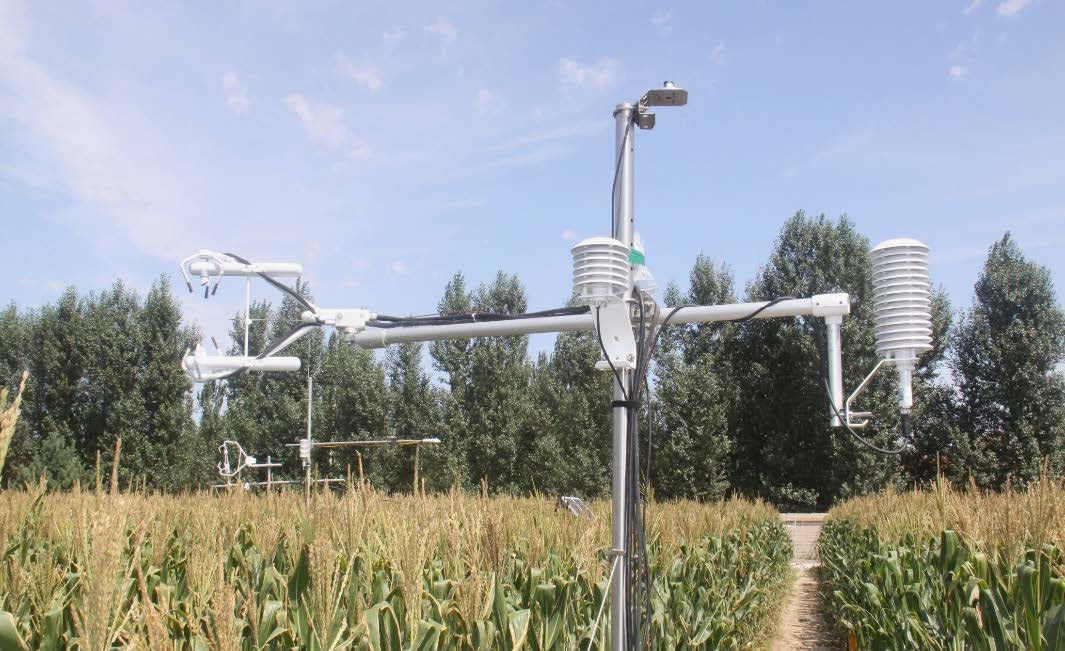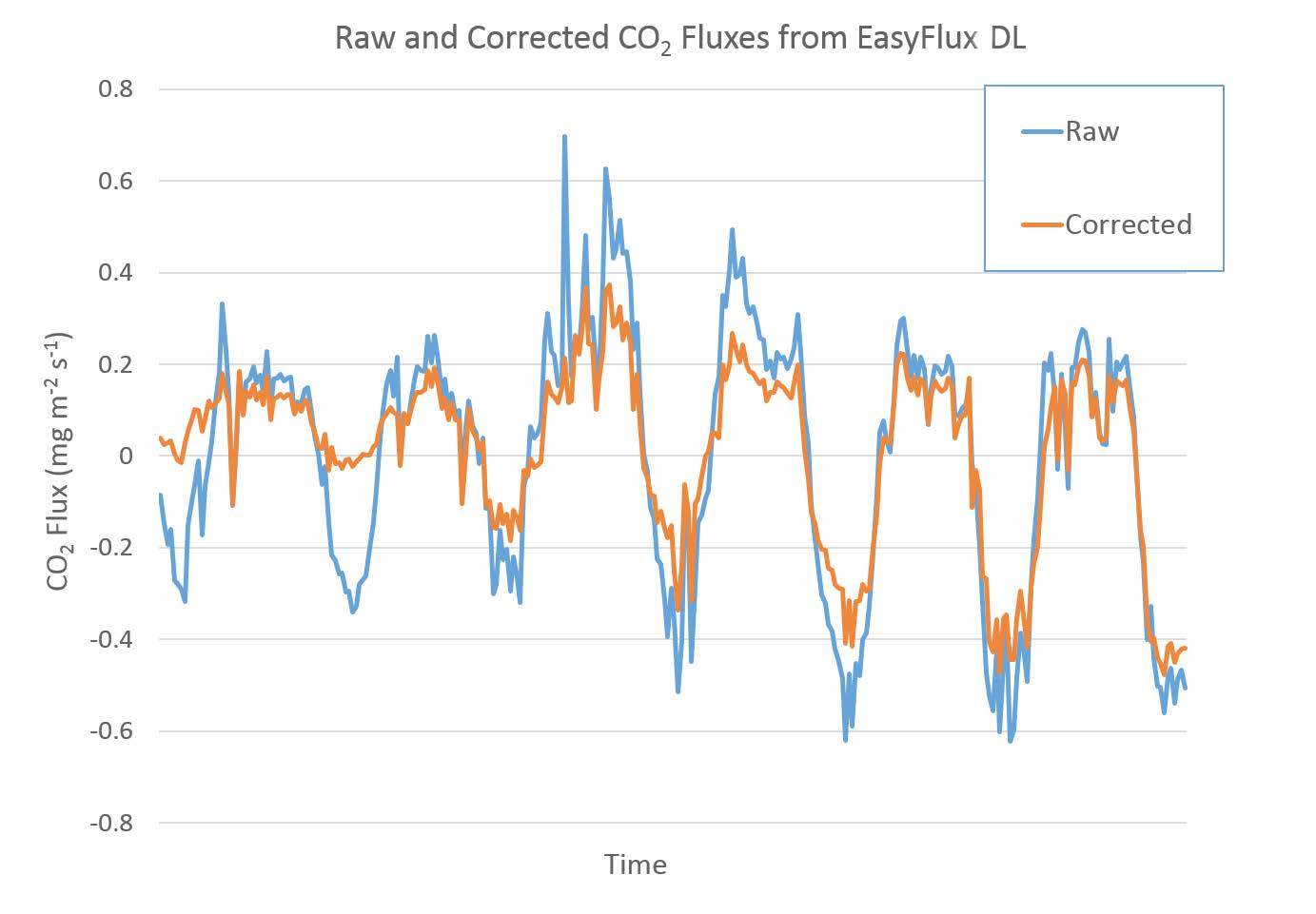
EasyFlux™ DL is a free CRBasic program that enables a datalogger to report fully corrected fluxes of CO2, latent heat (H2O), sensible heat, and momentum from a Campbell Scientific open-path eddy-covariance (EC) system. Final fluxes are processed from raw high frequency time series data by applying commonly used corrections found in scientific literature.
In the past, Campbell Scientific datalogger EC programs roughly estimated fluxes, and PC post-processing software was used to fully correct the flux measurements. Now with the EasyFlux DL program, fully corrected fluxes are processed by the datalogger and reported at the end of each EC averaging interval. Also provides many other variables of atmospheric properties, instrument diagnostics, intermediate correction, and other energy balance or biomet sensors.
EasyFlux DL has been tested at several stations in various environments, including irrigated alfalfa, grassland, maize, open water, forest, and desert. The results have shown good agreement with fluxes processed using traditional PC-based software applications.
Benefits and Features
l Accesses final fluxes quickly without the burden of post-processing
l Produces flux output tables that are smaller than time series tables, which allows flux data to be frequently collected using cellular, radio, or other lower-bandwidth telemetry options
l Available, at no charge; see Downloads section on website
l Matches the fluxes provided by PC post-processing software packages (assuming same filtering of raw data and same selection of correction procedures)
l Saves high frequency time series to removable media in case reprocessing is later needed
l Includes data quality and footprint characteristics
l Reports uncorrected and intermediate values in an auxiliary output table for more detailed data inspection
l Provides for CR6 program fully processed data output in AmeriFlux format
Supported Sensors
Required
l IRGASON Integrated CO2 and H2O Open-Path Gas Analyzer and 3-D Sonic Anemometer
l EC150 CO2 and H2O Open-Path Gas Analyzer with CSAT3A 3-D Sonic Anemometer
l CR6 or CR3000 datalogger
l NL116 or CFM100 (CR3000 only)
l 27158 (2 GB) or 33288 (8 GB) microSD Flash SLC Memory Card (CR6); CFMC2G or CFMC16G CompactFlash Card (CR3000)
Optional*
l CDM-A116 for CR6 with energy balance sensors
l FW05, FW1, or FW3 Fine-Wire Thermocouple
l HC2S3 or HMP155A Temperature and Relative Humidity Probe
l CNR4, NR01, or NR-LITE2 Net Radiometer
l CS300 or LI200RX Pyranometer
l LI190R Quantum Sensor
l SI-111 Infrared Radiometer
l TE525MM Tipping Bucket Rain Gage
l TCAV Averaging Soil Thermocouple Probe (quantity up to two)
l CS616 or CS650 Water Content Reflectometer (quantity up to two)
l HFP01 or HFP01SC Soil Heat Flux Plate (quantity up to four)
Main Correction and Processing Procedures
l Despike and filter high frequency time series data using sonic anemometer and gas analyzer diagnostic codes, signal strengths, and measurement output range thresholds.
l Apply coordinate rotations with an option to use the double rotation method (Tanner and Thurtell, 1969) or planar fit method (Wilczak, et al., 2001).
l Lag CO2 and H2O measurements against sonic wind measurements for maximization of CO2 and H2O fluxes (Horst and Lenschow, 2009; Foken et al., 2012), with additional constraints to ensure lags are physically possible.
l Apply frequency corrections using commonly used cospectra (Moore, 1986; van Dijk, 2002; Moncrieff et al., 1997) and transfer functions for block averaging (Kaimal et al., 1989), line/volume averaging (Moore, 1986; Moncrieff et al., 1997; Foken et al., 2012; van Dijk, 2002), time constants (Montgomery, 1947; Shapland et al., 2014; Geankoplis, 1993), and sensor separation (Horst and Lenschow, 2009; Foken et al., 2012).
l Apply a modified SND correction (Schotanus et al., 1983) to derive sensible heat flux from sonic sensible heat flux following the implementation as outlined in van Dijk (2002). Additionally, fully corrected sensible heat flux computed from a fine-wire thermocouple is provided if our FW05, FW1, or FW3 is used.
l Apply correction for air density fluctuations using Webb et al., 1980.
l Assign data quality classifications based on steady state conditions, surface layer turbulence characteristics, and wind direction following Foken et al., 2012.
l Calculate footprint characteristics using Kljun et al., 2004 or Kormann and Meixner, 2001.
l If energy balance sensors are used, calculate energy closure based on energy balance measurements and corrected sensible and latent heat fluxes.

Figure 1. Fully corrected fluxes are calculated using EasyFlux DL over a field of maize.

Figure 2. CO2 fluxes over maize are calculated and compared using EasyFlux DL and EddyPro? (LI-COR, Inc., Lincoln, NE) after applying similar diagnostic and despiking filters to raw data. Data shown represent half-hour fluxes taken over a four-day period in August.

Figure 3. Corrected CO2 fluxes from EasyFlux DL are compared to uncorrected CO2 fluxes over a week period from an irrigated alfalfa field soon after the alfalfa was harvested.
|

